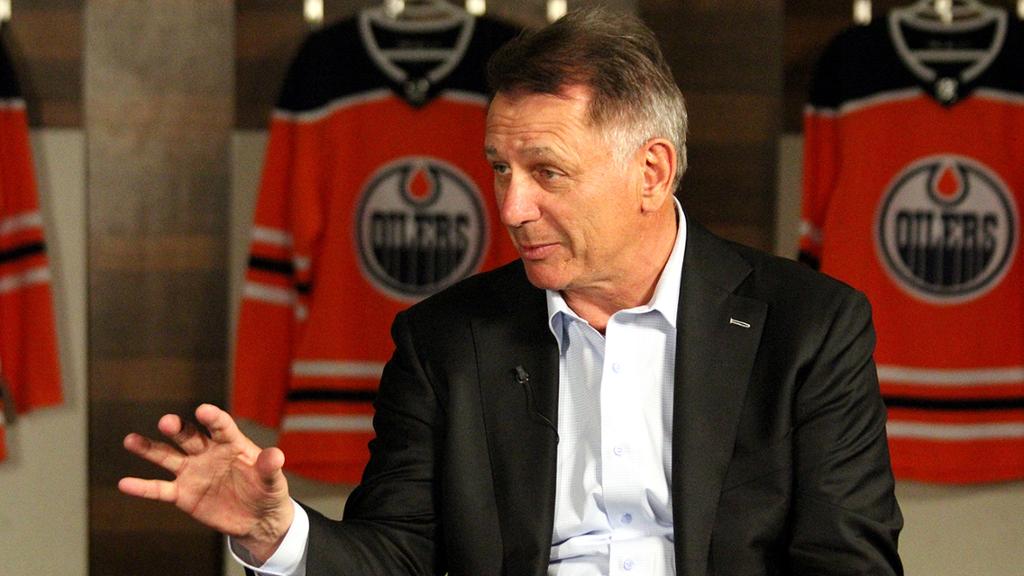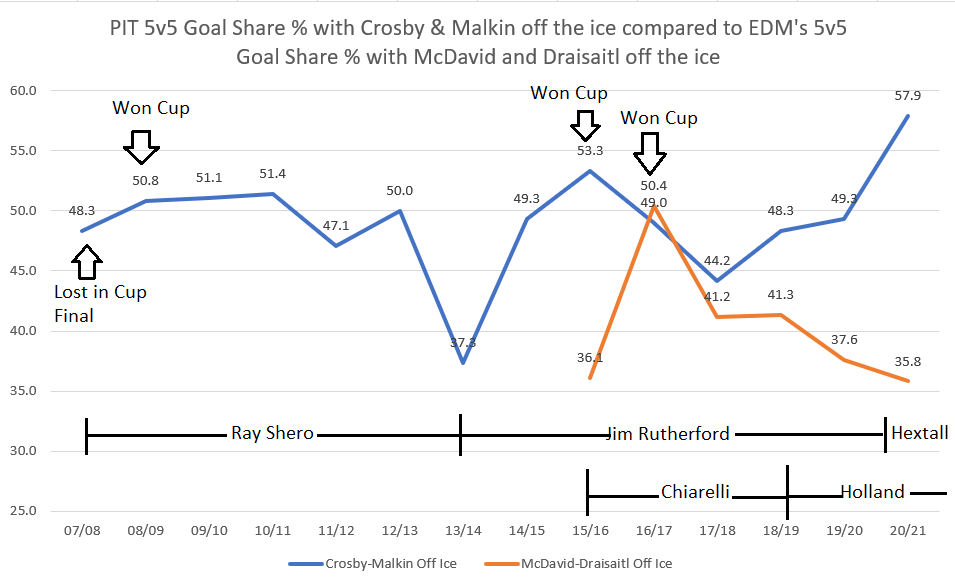The best two offensive players in the National Hockey League play for the Edmonton Oilers. That’s how good Connor McDavid and Leon Draisaitl are. They are both franchise building blocks, and the Oilers have been blessed with both of them. Jesse Puljujarvi returned from Finland this season and scored at a pace that would see him score 20 goals in a full 82-game season.
Those three, combined with a promising young Kailer Yamamoto, who should settle in as a 40-point player in the NHL, give the Edmonton Oilers a solid start to their roster. If the club can re-sign Ryan Nugent-Hopkins, they’ll have five real options for their top-six come 2021-22. That’s pretty darn good.
The only issue? The Oilers really have nothing below them when it comes to scoring depth. The Oilers have plenty of players in their bottom-six forward group who can kill a penalty, but very few who can actually contribute on the scoreboard.
With their top-end talent, dominant powerplay and improving defense, the Oilers should once again be in the dance when the 2022 Stanley Cup Playoffs open up. The goal is no longer to just make the playoffs, however. It is to win rounds in the playoffs, and eventually to win a Stanley Cup.
The Oilers have lost each of their last three playoff series, and have gone one-and-done in each of the last two tournaments. In that span, the club is 1-7 in playoff games, and 0-3 in overtime affairs.
The top-end talent can get them there and can make a difference in playoff games. In order to win a series, and eventually a Cup, the Oilers must get more contributions from the rest of their lineup.
That, friends, is where GM Ken Holland must get to work this summer. Since the day he was hired, Oilers media and the insiders around the club warned of two summers where Holland would be ‘handcuffed’ by the mess left by Peter Chiarelli. Those summers have now passed, and Holland should technically be free to do what needs to be done, even with a flat-cap due to COVID-19.
Depth Is The Way To Playoff Success:
Jonathan Willis of ‘The Athletic’ pointed out an alarming stat on Monday night following Edmonton’s triple overtime defeat at the hands of the Winnipeg Jets in Game 4. The loss, which completed the sweep for Winnipeg, proves the point of Edmonton’s lack of depth.
By five-on-five points in the 2020-21 season, here’s what Edmonton’s forward group looked like on Monday night.
Leon Draisaitl (40 points) – Connor McDavid (56) – Kailer Yamamoto (16)
Devin Shore (6) – Ryan Nugent-Hopkins (14) – Zack Kassian (5)
Tyler Ennis (9) – Gaetan Haas (3) – Jesse Puljujarvi (19)
Ryan McLeod (1) – Jujhar Khaira (11) – Alex Chiasson (9)
Both Draisaitl and McDavid scored at elite rates this season, while Puljujarvi was solid in the second-half of the season when promoted to the top-six. Yamamoto’s number is down, but he dealt with slump and injury and can be reasonably expected to rebound next season.
After that? The club badly needed more from Nugent-Hopkins, who just couldn’t give it to them. That should impact the dollar amount on his next contract. In fact, the Oilers could let him go and upgrade on him in free agency with a player like Blake Coleman or Zach Hyman.
Beyond Nugent-Hopkins? There just weren’t any real options for scoring depth.
Zack Kassian has completely fallen off since signing his new contract in January of 2020. He was solid in Games 3 and 4 against the Jets, but had a putrid regular season when he wasn’t hurt. He’ll likely be back next season because of that contract, and must improve for the Oilers.
Alex Chiasson, much like healthy scratch James Neal, is a powerplay specialist. Both Neal and Chiasson provide minimal value at five-on-five, and the club could improve by walking Chiasson and buying out Neal this summer. That frees up cap space and roster space for more impactful five-on-five players. An internal candidate like Tyler Benson could prove more useful.
There are plenty of moves that the Oilers can make to improve five-on-five scoring. We’ll touch on them in the coming weeks in detail, but for the moment, it’s this stat that should bother fans and Ken Holland
The Oilers dressed just two players, McDavid and Draisaitl, who scored 20-or-more five-on-five points this past season. The Jets? They had seven players who did that in their lineup on Monday night.
Winnipeg was, by far, the deeper team. They got the bounces, they got the wins.
Improving Goal Share is Holland’s Top Priority:
So, what does improved depth scoring look like? Well, it looks something like what the Pittsburgh Penguins have done. Like the Oilers, the Penguins have two superstar players in Sidney Crosby and Evgeni Malkin on their roster. Unlike the Oilers, they have invested in scoring and skill around their star players.
The results? 15 straight appearances in the playoffs and three Stanley Cup Championships. In a salary cap world, the Penguins are the gold standard for Edmonton to follow.
Unfortunately for McDavid and Draisaitl, both Chiarelli and Holland have failed to follow the blueprint laid out by Ray Shero and Jim Rutherford.
Woodguy (on Twitter here) does an excellent job over on his blog ‘Because Oilers‘ and recently posted a very interesting graphic comparing the Penguins and Oilers five-on-five goal share percentage when Crosby and Malkin are off the ice compared to when McDavid and Draisaitl are off the ice.
As Woodguy points out, the Oilers are substantially below the Penguins in every season except for 2016-17. That year, while the Penguins won a Stanley Cup, the Oilers went to Game 7 of the second round, and were a bounce away from the Western Conference Final.
In all three seasons that the Penguins won the Cup, they were over 50% in goal share when Crosby and Malkin were off the ice. That is the making of an elite team.
This season, the difference is stark. The Penguins got 57.9% of the goals with their top players off the ice, while the Oilers managed just 35.8%. That number, quite frankly, is pitiful.
Both teams made the playoffs, in large part thanks to their stars. The Penguins won a very difficult division, while the Oilers finished second in an average North.
Both teams enjoyed regular season success, but only the Penguins remain in the playoffs as of this writing. Even if they lose to the Islanders in the first round, they can point to goaltending as the reason, not secondary scoring.
So, the path forward is quite clear for Ken Holland. The Oilers have the core pieces in place, but do not have the quality depth needed to go deep in the Stanley Cup Playoffs. Holland even admitted that on Wednesday in his year end press conference. That should give fans the confidence that something will be done to at least improve this area.
The off-season blueprint is clear as day. The club needs both improvement from within (Ryan McLeod, Yamamoto, Benson) and external additions through either trade or free agency to augment their core pieces at the top of the roster.
There is another issue, however, and it isn’t on what the plan is. The other issue is whether or not Holland is the right guy for the job.
@NHL_Sid on Twitter does an excellent job of breaking down the Oilers. He recently posted a graphic showing Edmonton’s five-on-five goal percentage with both McDavid and Draisaitl off the ice.
As we can see, the numbers have consistently dipped since the 2016-17 season. They’ve taken an alarming downturn in each of the last two seasons. Peter Chiarelli was rightly fired for the work he did in Edmonton. His last season, 2018-19, featured the Oilers getting just 41.3% of goals without the two star players.
Somehow, that number has been worse since Holland took over. As the chart shows, Edmonton got just 37.6% of goals with McDavid and Draisaitl in 2019-20, and just 35.8% this season. Neither number is even remotely good enough.
Now, the Oilers made the playoffs in both seasons. They got there because their stars were so good, they had the best powerplay in the league both seasons, were top-ten in penalty kill both years and got great goaltending from both Mikko Koskinen (2019-20) and Mike Smith (2020-21).
They were able to cover the lack of goals without the stars in both regular seasons. In the playoffs? Their 1-7 record tells you everything you need to know.
Of course, Holland does get some slack in this regard. In both of the previous summers, he was working with cap restraints from the Chiarelli era. This summer, Kris Russell’s cap hit will go from $4,000,000 to a manageable $1,250,000. The buyout to Benoit Pouliot will come off the books, while Andrej Sekera’s buyout drops from $2,500,000 to $1,500,000.
Even a Holland overpay, Alex Chiasson’s $2,150,000 cap hit, is gone too.
Holland, for the first time as GM of the Oilers, will have salary cap room to work with. Perhaps in each of the last two summers, he was unable to fix the issues because he felt like he did not have the needed assets to get it done. That’s the bet the Oilers are making. That’s what Oiler fans have to hope is the case.
The time for low-risk bets on players like Kyle Turris has come and gone. Now, the Oilers need to step up and provide a supporting cast worthy of McDavid, Draisaitl, Puljujarvi and defenseman Darnell Nurse.
The Edmonton Oilers, even with minimal additions this summer, will be a playoff team in 2022 in a weak Pacific Division. In order to take that next level and threaten to be a Stanley Cup contender, however, the Oilers will need to improve their depth.
The number one thing on the ‘to-do’ list for Holland? Get the Oilers to roughly 50% in goal share when McDavid and Draisaitl are off the ice.
Do that, and next spring will be electric in Northern Alberta.
Add The Sports Daily to your Google News Feed!









